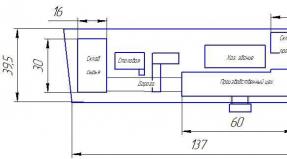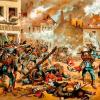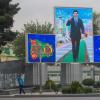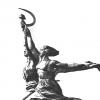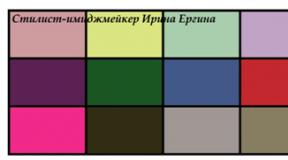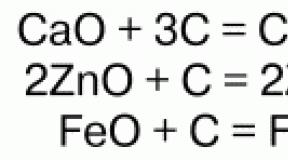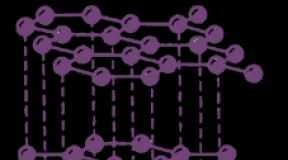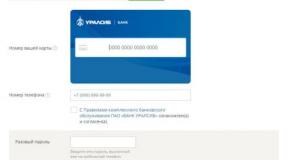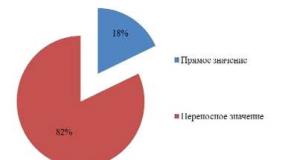The image of the company as an employer. Studying the image of an organization as an employer - its image in the internal and external labor market Factors that determine the image of an organization as an employer
The subject of studying the image of an organization is its image in the internal and external labor market. This study should provide starting points for measures to improve the image of the employer so that it is presented as a competitive advantage in terms of both potential employees and employees in the organization.
|
Directions of analysis |
Tools |
|
Personnel structure, including headcount, qualification structure, age structure, groups of employees by length of service in the organization, groups of employees by development potential, groups of employees by role status in the organization and its divisions |
Permanent and variable accounting data and personnel statistics. Information about the results of personnel training. Business assessment (certification) of personnel |
|
Personnel development structure |
Planning for personnel requirements, planning for filling vacancies, planning for personnel development activities |
|
Organizational structure, including formal hierarchy, informal structural groups |
Organization charts, organigrams, function performance diagrams, communication diagrams, surveys of employees and managers |
|
Organization of work, including staffing, jobs and their relationships |
Plan of positions and workplaces (staffing), description of work and positions (job descriptions), diagnostics of workplaces, employee surveys |
|
Management culture, including leadership style, socio-psychological climate, job satisfaction |
Methods of imperial social research, work with redundant employees |
|
Motivational Attitudes |
Employee surveys, group discussions, analysis of the application of motivation theories |
The image of an organization is formed by external influences from the business environment, as well as individual attitudes and preferences. Basically, the image exists as a subjective picture of the preferences and advantages of the organization acting as an employer.
The main task of image research is a correct understanding of those social and psychological factors that influence the decisions of potential applicants, jobs or the consolidation of existing employees of the organization.
Image research tools include:
- * conducting a survey of the opinions of employees of the organization, its partners, consumers and other groups of people;
- * analysis of recruitment campaigns, in particular unsuccessful recruitment activities, as well as recruitment activities from the circle of the inner circle of employees;
- * study of claims expressed by employees in the process of business assessment, adaptation or within the framework of a specially organized system for handling claims;
- * targeted analysis of labor market research data.
With the help of the information function of personnel marketing, it is possible to identify those areas that can make it difficult to provide long-term human resources. These areas include, for example, the tense state of the labor market, the backward systematization of professions and positions, or the negative image of the organization.
The influence of personnel marketing on the solution of such situations consists in the performance of a purposeful communication function.
"HR officer. Recruiting for a personnel officer", 2008, N 1
The image of the organization in the eyes of potential and real employees is no less important than the idea that partners and customers have about it. How do the requirements for specialists characterize the company? What features of a corporate brand are first of all noticed by newcomers? Part of the joint study of the headhunting agency RosExpert and ECOPSY Consulting is devoted to answering these and other questions.
Research "Image of the company as an employer"
Objectives: to identify the factors that determine the choice of a preferred place of work by candidates and contribute to the formation of their loyalty to the company, to establish the reasons for the development of job dissatisfaction and the most typical reasons for dismissal.
Research methods: expert interviews, in-depth interviews, questioning.
Scope of the study: 36 interviews (10 with HR managers) consisted of two parts (expert and in-depth). The remaining 26 interviews are in-depth.
150 high-potential middle managers were surveyed.
Place and time of the study: December 2007 - February 2008, Moscow.
The selection of respondents was carried out according to the database of companies RosExpert Executive Search and "ECOPSY Consulting"
What do HR directors of companies say in interviews with potential employees? As it turns out, salary is far from the first priority. The interviewed HR directors position their organizations in different ways in front of the candidates they are interested in, but mainly focus on the following perspectives: the opportunity to show independence and creativity, to realize their own ideas; scale of work; caring for employees; bonuses; training, professional and career growth; long, successful history of the company; development of the company (in particular, through work in a promising market segment or through leadership positions); the opportunity to "price up" your resume.
Do HR directors often deceive applicants about their prospects in a new job? HR managers themselves say no. They are convinced that it is inappropriate to give candidates incorrect information about the organization. After all, if they come to the company, they will quickly be convinced of the fallacy of their expectations and quit.
Some HR directors who work in structures with a good image even find it necessary to "cool down" overly enthusiastic applicants, trying to form an objective vision of the company in them.
At the same time, HR managers who participated in the study are unanimous in their opinion that distortions in the ideas of candidates about the future place of work are always present and there are the following reasons for this:
In interviews with applicants there is always an element of agitation: they are told about the merits of working in the company, and they say less about the upcoming difficulties or simply remain silent;
The owners or employees of the organization may be absolutely sincere in praising it, but they rely on their own vision, which only to a certain extent reflects the real state of affairs;
How a person will be able to fit into the company, to a certain extent depends only on his readiness and skills, this cannot be predicted in advance;
In Russian companies, informal relationships often carry more weight than the formal ones that candidates are told about.
An analysis of the respondents' answers shows that many of them experience disappointment at the first moment when they move to a new job. Therefore, some companies introduce special programs that facilitate the adaptation process.
Strict requirements
Survey participants state that companies can be conditionally divided into two groups according to the specifics of filling vacancies.
Some organizations grow specialists and rarely attract people from outside. The vacated places are taken by their own employees, who are preliminarily prepared according to special training programs. Staff turnover in such companies is usually low. This category includes mainly foreign firms represented on the Russian market, as well as some domestic ones that have been operating for a long time and stably.
The companies of another group - mostly rapidly developing Russian ones - prefer to recruit "ready-made" specialists who already have the necessary set of professional skills and personal qualities. Such organizations are characterized by constant internal transformations, high staff turnover, and an active search for new people. Their requirements for candidates for leadership positions are largely similar. The applicant must:
Have successful management experience;
Be able to work in an unstable business environment, be resistant to stress, have positive thinking, independence and creativity;
Take responsibility and create "your niche" in the organization;
Be ambitious;
It is good to know what he wants (at the same time, personal goals and values \u200b\u200bshould not contradict corporate ones);
Be motivated to work;
Have a positive attitude towards the owners of the company.
"Experiments to attract people from other industries have been going on for several years, and there are practically no successful transitions. In our high-tech sector, only specialists become managers, because a leader who does not have specific knowledge simply cannot understand what they are talking about subordinates." (Hereinafter, in quotation marks are the words of HR directors and top managers who participated in the study.)
An approach is becoming popular that defines leadership as an innate ability of a person that can and should be improved, but cannot be formed if it was not initially laid down.
Those respondents who are responsible for working with personnel in their organizations do not want to hire candidates who are looking for a "safe haven" where they can not take on responsibility that goes beyond the narrow circle of their duties, be at work "from and to" and receive solid financial reward. We also have to weed out professional "sellers of themselves" - specialists who move around organizations for the sole purpose of increasing the price of their resume. The discussed side of the corporate brand of the company as an employer may have its own distortions:
The organization overestimates the degree of its own attractiveness for candidates and tries to attract super professionals who are not interested in it;
The management of the company talks about one set of expectations, but in reality has another in mind, as a result of which there is dissatisfaction with the choice made. This problem is often faced by owners who are looking for successors in the person of hired top managers;
Employer's expectations are not adequately reflected in messages informing job seekers. Therefore, a lot of "superfluous people" get into the competition. The interviewed HR managers do not voice this as a problem. Moreover, a large number of resumes for one vacancy (30 - 40) is for them a confirmation of the prestige of the company in the labor market. However, foreign specialists in the field of personnel marketing tend to consider such a result as an indicator of the incorrect positioning of the organization. They try to weed out unnecessary candidates throughout the entire search process, starting with the announcement of the competition.
Ideally, the "external" and "internal" views of the company's corporate brand should match. So far, rare organizations (mostly Western ones) manage to achieve such harmony. In the overwhelming majority of cases, there is a discrepancy between the information received by candidates at the first stages of employment, and the reality that they face when entering a new job. The respondents understand this very well, so one of the main criteria by which they evaluate organizations is the fulfillment of promises. Promises can be broken both intentionally and unintentionally. More often than not, the latter happens. Employers sometimes overestimate the prospects and speed of development of their company, so those plans that attract specialists are implemented much more slowly than expected.
What else do newbies pay attention to?
Fairness of the system of rewards and punishments
According to respondents, there are several typical forms of manifestation of injustice:
Employees of the organization, occupying similar positions, have different salaries and different benefits. This happens, for example, if the organization has a privileged head office and branches, where it is less profitable and prestigious to work. A similar situation arises if one person grows within the company, and another comes from the outside on a higher salary, taking into account the "overpayment coefficient";
The same positions are occupied by specialists with different skill levels. This is a typical situation for companies that have not developed qualification standards;
Employees who perform managerial functions have more social and material incentives than narrow specialists, although the latter may be unique in their field, while management is often represented by "young ambitious boys" without much merit;
It is not the one who is really to blame who is responsible for the failure of a company in business. "A good organization will never set up its employees. It will not place someone else's blame on them for not completing the project";
Achievements of employees are not encouraged, they are "not noticed and not appreciated."
One of the interviewed HR managers emphasizes that "when processes are clearly built in a company, there is an illusion of fairness. When decisions are not made on the basis of paperwork or rigidly established regulations, then the thought involuntarily arises that it is made subjectively."
Type of corporate culture
Foreign studies show that there is a general trend towards the democratization of corporate culture. “Employees no longer want to be controlled,” says Marsha Reynolds, author of Coaching: Emotional Competence. “Where fear used to drive a person to work hard, now it is the cause of depression and leads to employee turnover and reduced productivity. ". "Managers are increasingly moving from overseers to mentors," write Patrick McKenna and David Meister in First Among Equals.
This study also reflects this trend. Many elements of the authoritarian corporate culture cause expressed dissatisfaction among the respondents. This is due to the following characteristics of such a system:
Privileges and unavailability of management. "Top managers show too much concern about status: some kind of privileges, benefits. These things are personally unpleasant for me. People cannot directly contact the leader";
The inability to influence the decision-making process, even when it directly affects the interests of the employee.
“I was on vacation when the default happened. And when I returned, I received a salary at the old rate. For me, financial losses are not so important, but no one asked my opinion! No one consulted me”;
Strict control over the activities of employees, demonstrating distrust of them, suppressing their independence and creativity.
Respondents also identify two types of relationships within companies: those built on a personal or business basis. According to the respondents, at the initial stage of the development of Russian business, the first type of relationship prevailed, in which "an informal structure could dominate over a formal one." Now the system is becoming more formalized. However, employees accustomed to the dominance of personal relationships, painfully perceive this process. “People don’t like the fact that emotional warmth is leaving, the feeling of “one’s own company” is disappearing.
Employee care
The study participants believe that organizations that care about employees provide them with comfortable and safe working conditions, a social package, and protection of rights in accordance with labor laws.
The main negative difference between domestic companies and Western companies, according to the respondents, is "lack of true care." "A person does not get help in a really difficult situation, but they give him a formal New Year's gift."
Opportunities for professional growth and development
In stable operating companies (mainly Western ones) interested in the training of personnel reserves, the participation of employees in special training programs is traditional. Domestic business structures prefer to hire ready-made specialists and tend to fire rather than train those who cannot cope. Therefore, professionalism can grow only within the framework of the performance of official duties. Fast-growing companies can drive continuous growth by challenging employees to bigger goals and engaging them in new businesses. In the most unfavorable light, organizations that have stopped developing and neglect the need to train personnel according to special programs appear before employees in the most unfavorable light.
Career Opportunities
Companies that grow their workforce are also attractive to job seekers. Career growth in them is predictable, but there are a number of difficulties:
Promotion takes place in strict accordance with corporate standards, as a rule, rather slowly;
At a certain moment (closer to the top positions), the promotion stops.
Companies focused on ready-made specialists do not guarantee anything, but give the most “toothy” a chance to quickly break through to the top. People who are not ready for tough competition feel better in structured organizations. Ambitious, self-confident professionals quickly exhaust the opportunities provided by such organizations and make a career in companies of the second type.
Structured management
According to respondents, professionalism in management implies "structured business processes and prescribed business procedures." In companies with this quality, employees are attracted to:
Clarity of goals, both general and individual;
Continuous monitoring of the state of the business;
Definiteness of criteria for evaluating the results of work;
Saving effort due to the fact that the algorithms of actions in various situations are known;
Fewer opportunities for the manifestation of the "dictatorship of individuals."
In general, this management system looks more fair, but it can suppress the independence and creativity of employees if it crosses the line separating order from formalism. An unstructured business can be convenient for those professionals who want and can "form their own niche" within the company.
Communication within the company
According to the respondents, the coherence and efficiency of work depends on the quality of communication between different departments of the organization, as well as between managers and subordinates. The following factors can hinder effective communication:
The structure of the company;
Pressure from internal security services;
The special status of the company's management (in particular, its inaccessibility for subordinates).
Communication violations are reported by respondents working both in domestic and foreign firms.
Depending on what stage a company is at, its reputation building priorities change. The attitude to one's image can serve as an indicator of maturity. When a company first enters the market, the most important thing for it is the attitude of customers, since its profit directly depends on it. At the next stage of development, the company faces the task of attracting new employees who have already had successful work experience, as well as expanding relationships with partners. The opinion about the company in the market becomes no less important than the reputation of the customers.
The illusion of a good corporate brand can be created, but it will only work until customers, partners, and employees of the organization discover the difference between real actions and PR moves. It is impossible to earn a reputation solely by PR methods, unlike the image, it is a longer-term product.
Material provided
"ECOPSY Consulting".
Signed for print
INTRODUCTION
The relevance of research. The image of the organization is a factor affecting its competitiveness, pricing and image of its products, the quality of the clientele and partners, in all spheres of the organization's life. Creating the right image helps the client to perceive the activities of the organization, the product it produces as something different from other similar products. At present, a positive image of the organization is an important component of success.
Creating a favorable image is one of the key links in the organization's activities to promote its products to the market, to achieve competitive advantages. Thanks to a properly created image of the company, its value increases significantly. In the US, according to a study by Interbrand, up to 95% of management rate a positive reputation as an extremely important factor in the development of their business. 75% believe that it has a strong influence on the promotion of the company. 60% believe that it is a good image that attracts the best professionals to the organization.
Creation of the image of the organization is formed from several components: the image of management, the image of the staff, the social image, the product image, corporate culture, corporate identity, the business component of the image of the organization. Each employee is considered as the “face” of the entire organization, by which the staff as a whole will be judged. In the public mind, rather persistent stereotypes have developed regarding the socio-demographic profile of employees of certain institutions. It is important to break the existing negative stereotypes and attitudes and replace them with positive ones that have a beneficial effect on the image of the organization.
The degree of development of the topic. Consideration of the image from the point of view of management is undertaken in serious studies by G. Dowling, F. Kotler, Robert P., J. Beaudoin. G. Dowling and Robert P. consider the creation and reputation of the company, management and performance evaluation. F. Kotler, J. Beaudoin and D. Cowley consider in more detail the management of the organization's image and methods of its research. Thus, the authors give a comprehensive analysis of the various mechanisms for the formation and management of reputation, define the concepts of image and reputation.
The theoretical and methodological basis of the study was a number of studies that examine the processes, techniques, methods and mechanisms of image formation.
Subject of study: the image of the organization's personnel.
Object of research: features of the influence of the image of the staff on the image of the organization.
The purpose of this work is to study the image of the staff as a component of the image of the organization.
CHAPTER 1. THEORETICAL FOUNDATIONS OF STAFF IMAGE AS A COMPONENT OF ORGANIZATION'S IMAGE
.1 The concept of the image of the organization and its types
The image is understood as a set of impressions from communication with the organization. THEM. Sinyaeva defines the image of the organization as follows: “Corporate or organizational image is the image of the organization in the representation of public groups. The commercial success of any enterprise for a long time is determined by the steady receipt of profit through the sale of manufactured products (services) to consumers and lies in the ability to ensure that buyers in a competitive environment give preference to this particular product. To a large extent, the stable commercial success of the enterprise is facilitated by its positive image.” A more complete definition of the image is given by M. Medvedev. The author writes that in the content of this concept, it is necessary to see two facets:
image as a purposefully formed information-figurative construct that holistically characterizes the subject of marketing communication and is addressed to the audience with the aim of emotional and psychological impact on it;
image as an image subjectively perceived by the audience, containing the essential characteristics of the subject of marketing communication (personality, organization) and expressed in assessments, judgments, forms of consumer behavior.
The structure of the organization's image is shown in Figure 1.
Rice. 1 - The structure of the corporate image of the organization
The business image of an enterprise is made up of the partners' ideas about the enterprise as a subject of a certain activity. The main determinants of the business image are: business reputation, or conscientiousness (observance of ethical business standards) in the implementation of business activities, reliability, loyalty of the enterprise to partners, information openness, as well as the business activity of the enterprise, the indicators of which are sales volume, the relative share market, a variety of goods, pricing flexibility.
The social image of an enterprise consists in the perceptions of the general public about the social goals and role of the enterprise in the economic, social and cultural life of society. The social image is formed by informing the public about the social aspects of the enterprise, such as sponsorship, patronage, support for social movements, participation in solving problems of the environment, employment, healthcare, etc., assistance to specific individuals.
The image of an enterprise for state structures is made up of representations of the enterprise by representatives of the regional administration, executive and legislative authorities. The image parameters for government agencies are: the importance of the enterprise's products for the region, the degree of participation of the enterprise in regional social programs, the implementation of federal and regional laws by the enterprise, the number of jobs provided for residents of the region, the openness of the enterprise to informal contacts.
The internal image of the enterprise is formed by the staff's ideas about their enterprise. At the same time, the personnel is considered not only as a factor in the competitiveness of the enterprise, one of the key groups of the public, but also as an important source of information about the enterprise for external audiences. The main determinants of the internal image are the culture of the enterprise (the system of personnel selection and training, the system of management and subordination relations, the system for evaluating the work of personnel based on criteria adopted by the enterprise, the remuneration system, the system of social benefits, the corporate identity of the enterprise) and the socio-psychological climate (mood and opinion collective, individual well-being and assessment of the living and working conditions of the individual in the team).
Priorities of public groups in image work can change. State structures that regulate the activities of industries, discerning consumers, the broad Russian or international business community may have different priorities in the organization's communications. The domestic market, even at the expense of imported goods, is turning from a "seller's market" into a "buyer's market". There are signs of promotion of the Russian production of services and goods, even if under pressure from foreign competitors. All this causes a growing need for the Russian commodity producer to expand the range of target groups in working with the public, to deepen this work on the basis of modern achievements in the theory and practice of Public Relations.
Each organization has the right to choose for itself the content of the external and internal image. Some organizations combine the features of different image orientations. That can give them an edge over their competitors. It should also be noted that there is no uniquely correct image that all organizations should follow, any approach has its pros and cons. The most important thing in image planning is to research the organization and customer loyalty. Find out what kind of organization would like to see its owners, employees and customers.
1.2 Features of the image of the organization's personnel and methods of its formation
The presence of a positive representation of the staff towards their company leads to team building, gives confidence in the future to each individual employee, thereby stimulating him to a greater degree of identification with the company, more active work and dedication to the common cause, the desire to improve their own qualifications, which, in turn, turn, has a positive effect on the external image of the company as a stable, professional organization, a good employer, etc.
HR programs include:
The personnel policy of the company: the level of wages, the authority of an employee in a particular position, the possibility of promotion through the ranks, bonuses and internal communications.
Orientation and training of employees: a key link in creating an idea of the company and its standards among employees. Trainings give staff the knowledge and motivation they need to present the company to customers. Staff orientation and training determine how effectively employees will establish emotional bonds first with the company and then with customers, how competently and professionally they will perform their duties.
Reward programs: the most effective way to create high motivation and morale of the staff. These programs address the basic emotional need of a person - the desire to feel important and the need for approval from others.
The image of the staff directly affects the image of the company as a whole. If we form an image using certain information, we will attract one segment of consumers, another segment will be focused on other information. It follows from this that an incorrectly chosen corporate identity for our products, although it will cause people to think positively about the company's image and product quality, will not increase the percentage of sales and profits of our company, because it will affect the wrong segment.
There are the following methods of forming the internal image of the organization:
Work with corporate culture. Corporate culture consists of ideas, attitudes, fundamental values that are shared by the members of the organization.
Table 1 - The main areas of work on the formation of corporate culture
Values1. Acceptance of the organization's mission and core values. Each person has his own system of values (establishing harmonious relationships with other people, achieving personal well-being, realizing one's potential, etc.). Each company has its own value system (maximizing profits, developing relationships with customers, promoting new technologies, etc.). An employee will be loyal to the organization, and will be satisfied with the work in this company, if these value systems are consistent and match in key positions. Identity2. Forming a sense of unity with the company If an employee believes: "I and the company are one," this means that the company has achieved the highest level of loyalty. What is a positive result of the development of corporate culture. Symbols3. Acceptance of symbols for awareness of unity The means of forming loyalty to the company at this level is the corporate style, including overalls, logo, etc. For example, sales assistants dressed in beautiful uniforms with the company logo develop a sense of unity with it, pride, ideally confidence that they work in the best organization. Behavior 4. Development of standards of conduct Employees are loyal to the company at the behavioral level if they comply with all its requirements, rules and regulations. An important condition for this is the description, formalization and implementation of standards. Development5. Development of abilities At this level, an individual approach to each employee is required. To increase the loyalty of an employee, the company must recognize him as a person, establish partnerships with him, openly declare that he needs his loyalty. Beliefs6. Formation of loyalty as an inner conviction Loyalty as an inner conviction must be nurtured. In particular, loyalty to the company-employer may arise under the influence of the leader and / or in the process of team building trainings.
Organization of formal and informal in-house events: corporate holidays, corporate training, adaptation trainings, professional competitions, meetings, meetings, briefings, management speeches, etc.
Internal media (newspapers, website, stands, leaflets, messages, etc.), the purpose of which is to:
increase the competitiveness of the business, by greater involvement of employees in the life of the company;
reduce staff turnover, increase staff loyalty to the company, increasing the effectiveness of non-material motivation of staff;
improve the quality of intergroup cooperation (cooperation between different departments, branches of the company), correspondence acquaintance of employees working in different offices of the company;
clarify labor and social issues;
inform employees about current events related to the activities of the enterprise.
Internal PR specialists are called upon to establish links between individual subjects of the internal environment of the organization and support the process of two-way communications. To accomplish their tasks, they use the following means and channels for disseminating image-building information:
issuance of an internal newspaper, the main task of which is “to create a feeling of a united family in the team, to strengthen confidence in the management, to explain the organization’s policy, to attract employees to cooperate with the administration, to awaken their interest in the affairs of the organization”;
the use of a bulletin board, which is designed to serve as a tool for the prompt delivery of information, leads to a degree of personalization of communication;
organization of personal meetings between company managers and their employees, which are of great emotional and psychological significance for the company's employees;
holding general meetings and briefings, which provide additional opportunities for direct communication between managers and other employees of the company, for the exchange of information, opinions and ideas.
All these means will be effective only if the feedback works, i.e. there is a bilateral exchange of information and opinions. Work on internal PR is long-term. The created image of the organization must be constantly maintained.
Based on world and Russian practice, it can be argued that in order to create a positive internal assessment of the company's image, the following recommendations must be followed:
to constantly maintain a good psychological climate in the team, which largely depends on the ability of the manager, to promote not only professional, but also personal communication among employees of individual departments, to carry out all sorts of actions for joint spending of non-working time, to create an environment of healthy, not hostile competition between employees, mutual respect , mutual assistance, mutual trust, etc.; in addition, managers should avoid conflict clashes with employees;
contribute to the improvement of the skills of employees, demonstrate the need for highly qualified personnel, thereby stimulating employees for professional achievements, make high demands when hiring, which gives employees a sense of the special value of the workplace, high standards increase the attractiveness of the company in the eyes of candidates for vacancies;
to inform and involve employees, shareholders, other subjects of the internal environment in innovative projects, to enable creative and professional realization of people;
give systematic information about the latest achievements of the company and its successes, focus on the abilities and characteristics of the company and its employees, on specific production skills and know-how in technology, on explaining future projects and goals of the company, etc.;
inform employees about the history of the company, standards, norms of behavior in the team, ethics and etiquette, by explaining these elements of corporate culture in the relevant instructions, internal charter;
evaluate the performance of its employees and encourage their work.
The main and necessary mechanism for the implementation of the above principles is two-way communication between individual subjects of the internal environment and communication work in the organization, which requires serious costs.
Thus, the image of the staff image of the staff is the perception and psychological attitude towards the company of its employees. Functionally, the work on the formation of the image of the organization's personnel is divided between two services of the company: personnel workers and the PR service. Methods of forming the image of the organization's personnel used in internal PR: work with corporate culture; organization of intra-company events; domestic media.
Chapter 2
.1 Brief description of the organization and its personnel
Closed Joint Stock Company Nizhnevartovskstroydetal was registered on 04/06/1998. General Director Alexander Fedorovich Litus. The enterprise CJSC "Nizhnevartovskstroydetal" is located at the address: Nizhnevartovsk, st. Industrialnaya, 36 G.
The main purpose of the enterprise is to make a profit through the implementation of economic and other activities aimed at meeting public needs for goods and services.
Closed Joint Stock Company Nizhnevartovskstroydetal (abbreviated as CJSC Nizhnevartovskstroydetal) is one of the leading enterprises in the construction industry of the Khanty-Mansiysk Autonomous Okrug - Ugra.
According to the charter, the company can carry out the following activities:
production of industrial products: prefabricated concrete, prefabricated metal structures, mortar, metal structures;
implementation of construction, repair, commissioning, installation and other production and design work;
trade-purchasing and marketing activities;
motor transport services and transportation;
maintenance and repair of automotive and other equipment;
operation of lifting structures;
operation of boilers and vessels operating under pressure of steam and hot water pipelines;
provision of warehouse services;
loading and unloading activities on lifting and railway tracks;
introduction of research and other works and technological processes;
design, construction, restoration and repair of residential and industrial facilities, as well as cultural and community facilities;
transportation of goods by road;
implementation of other works and services that do not contradict the current law of the Russian Federation.
To date, the range of manufactured products includes more than 300 items of reinforced concrete products and structures for the construction of housing, industrial, social and cultural facilities. In the range of products manufactured by the plant, concrete, prefabricated reinforced concrete, and mortar occupy the main position (Fig. 2).
Rice. 2 - Distribution of sales volume in the group of leading products from the volume of total revenue for the group, %
Purposeful introduction of new technologies, constant quality control, and a serious approach to choosing organizations that supply materials for the production of Nizhnevartovskstroydetal CJSC help to maintain high product quality and update the range of products.
The company develops plans, marketing programs, implements programs to improve production efficiency, maintains its own accounting.
The plant has in its structure shops, sections, headed by a foreman or head of a shop, section. The plant includes research laboratories.
The structure of CJSC "Nizhnevartovskstroydetal" has the following services (organizational structure diagram - Appendix):
production - concrete mixing shop, mill shop, engineering structures shop, reinforcement shop;
technical - PTO, OTK, OGM and E;
supply and marketing - supply department, AHO;
production services - a repair and construction site, a mechanical repair shop, an energy shop, a finished product shipment shop, a control room;
controlling - TB, product quality control department;
employee services - canteen, health center;
accounting - material department, settlement department;
economic - planning and economic department, financial department.
Employees of the enterprise are usually divided into personnel of the main and non-main activities. According to the economic functions performed, the personnel of the enterprise are divided into workers and employees (engineering and technical workers). Workers include persons directly involved in the creation of wealth, repairs, provision of material services, etc. From the group of employees are distinguished:
leaders;
employees holding positions of heads of institutions and their structural divisions;
specialists - personnel engaged in engineering, economic and other work;
other workers - carry out economic services.
The source of information for the analysis of the composition and structure of labor resources is the report on the average headcount of ZAO Nizhnevartovskstroydetal for 12 months of 2011, 2012 and 2013. Data from the analysis of the composition and structure of labor resources are shown in Table 2.
The number of personnel in 2012 increased by 19 (680-661) people compared to 2011, and 4 of them are employees, which indicates an increase in the number of technical performers. In 2013, the average headcount increased by 53 people (733-680) compared to 2012 and amounted to 733 people, of which 4 are engineering and technical workers, the remaining 49 are workers. In 2013, the number of workers in the total number of employees was 636 people.
Table 2 - Analysis of the composition and structure of the workforce of ZAO Nizhnevartovskstroydetal in 2011-2013
Category Employee Employment Number, Cherts Structure of the average number,% Change Structure20/ 2012First activities, people661680733100100100 - including: Working57158663686,486,286,868686,486,286,80 + 0,2-0,213,813,4-0.2-0,2 + 0.4 Of which: Managers3330.50.50.4not change.+ 0.1Specialists87919513.213.413.0-0.2+0.4TOTAL661680733100100100--
Rice. 3 - The composition of the workforce of ZAO Nizhnevartovskstroydetal in 2011-2013, people.
Rice. 4 - The structure of the labor personnel of ZAO Nizhnevartovskstroydetal in 2011-2013, %
Sufficient provision of the enterprise with workers with the necessary knowledge and skills, their rational use, a high level of labor productivity are of great importance for increasing production volumes and improving production efficiency. In particular, the volume and timeliness of all work, the degree of use of equipment, machines, mechanisms and, as a result, the volume of production, its cost, profit and a number of other economic indicators depend on the provision of the institution with personnel and the efficiency of its use.
The provision of an enterprise with personnel is determined by comparing the actual number of employees by category and profession with the planned need.
The tension in providing the enterprise with labor resources can be somewhat relieved by a more complete use of the available labor force, an increase in labor productivity, intensification of production, comprehensive mechanization and automation of production processes, an increase in the level of technical equipment of the institution, improvement of technology and organization of production. In the process of analysis, reserves should be identified to reduce the need for labor resources as a result of the above and other activities.
If an enterprise expands its activities, increases production capacity, creates new jobs, then there is an additional need for personnel by categories and professions and sources of their attraction. The source of staff recruitment can be announcements in the media, cooperation with higher educational institutions, the employment service of the city.
The completeness of the use of personnel can be assessed by the number of days and hours worked by one employee for the analyzed period of time, as well as by the degree of use of the working time fund.
The source of information for analyzing the use of working time is the report on the average headcount of CJSC Nizhnevartovskstroydetal for 2011-2013. and form No. P-4 "Information on the number, wages and movement of employees" for 2011-2013.
The analysis data are shown in Table 3.
Table 3 - Analysis of the use of working time of ZAO Nizhnevartovskstroydetal for 2011-2013
Indicators201120122013Deviation (2013/2012)SymbolsAverage number of employees, persons 661680734+54HR incl. workers571586636+50sp. weight of workers in total. num. rab.0,860,860,86-worked by all workers: Dney130358139409143529 + 4120D + vseChasov100948910987231143320 44597CH vseOtrabotano one worker: Dney228238226-12D1rChasov176818751798-77Ch1rProdolzhitelnost workday B / D7,77,98,0 + 0,1PFond working time chas.100948910987231143320 + 44597FRV
Rice. 5 - Use of working hours of ZAO Nizhnevartovskstroydetal for 2011-2013
The actual fund of working hours in 2013 increased by 44,597 hours compared to 2012. The company uses the available labor resources insufficiently. On average, one worker worked 226 days instead of 238, as a result of which the whole-day loss of working time per worker increased by 12 days.
In order to achieve full compliance of collective and personal interests in improving the final results, Nizhnevartovskstroydetal CJSC has developed a regulation on the remuneration of employees. The regulation on the remuneration of employees of CJSC Nizhnevartovskstroydetal is introduced in order to strengthen the material interest of employees in achieving the final results of labor, improve product quality with the rational use of material resources and to display the creative activity of each employee.
A significant share is occupied by incentive payments, the share of which, for 2011-2013, is 35%. Incentive payments include various allowances, monthly financial assistance, payments for the implementation of the plan and other payments included in the payroll. The composition of incentive payments is shown in Figure 6.
Rice. 6 - Composition of incentive payments of CJSC Nizhnevartovskstroydetal for 2011-2013, thousand rubles.
It can be seen from the figure that among the incentive payments, the greater part is occupied by payments for the implementation of the plan - 15%, the share of which, compared to the analyzed years, remained unchanged. The smallest share (1.5%) in the wage fund is occupied by individual incentive payments, that is, monthly material assistance, which did not change in the analyzed years. It should be noted that even a slight change in incentive payments is a negative phenomenon. Therefore, it can be noted that with an increase in the number of employees of the enterprise, the amount of incentive payments remained the same, which means that CJSC Nizhnevartovskstroydetal fulfills its obligations to employees.
In addition to incentive payments provided by the wage fund, the company has incentive payments at the expense of profits. The largest indicator of payments is the social package of the enterprise. It includes subsidies for rest, travel, free meals, educational programs, provision of a car and a mobile phone to company executives and top managers, payment for kindergartens and nurseries, medical care and life insurance, providing employees with paid three-day leave, based on the tariff rate (salary ), in the event of: the death of a spouse, child, parents, siblings; the birth of a child; own wedding; children's weddings; provision of annual paid leave on September 1 to mothers or other persons raising schoolchildren (grades 1-4).
In order to strengthen the material interest of the team and the individual employee in fulfilling tasks and contractual obligations for deliveries, improving the technical level and quality of products, increasing labor productivity, observing the consumption standards of raw materials, materials, energy and heat engineering resources, Nizhnevartovskstroydetal CJSC developed a regulation on the formation and distribution of the bonus fund. In order to achieve full compliance of collective and personal interests in improving the final results, the accrual of bonuses for the main results of economic activity is carried out by teams of teams of workshops, services, departments and individual employees.
To determine the procedure for providing material assistance and payment of monetary rewards by anniversaries, social support for employees and pensioners of the company, the company developed a regulation on the payment of monetary rewards and the provision of material assistance. The Regulation determines the procedure for providing material assistance and payment of monetary rewards for anniversaries, social support for employees and pensioners of the company.
2.2 Study of the image of the organization's personnel
The research is carried out in 2 stages. The task of the first stage is to identify the state of the corporate culture and the socio-psychological climate as the main determinants of the image of the company's personnel. At this stage, interviews were conducted with the HR director, the HR manager, and the financial director.
The purpose of the study: to assess the image of the organization's personnel.
Object of study: internal communication environment of ZAO Nizhnevartovskstroydetal.
Research objectives:
evaluate the parameters of the internal corporate image;
determine satisfaction with the amount of information needed for work;
determine the satisfaction of employees with the working conditions in the company;
to study what changes, in the opinion of employees, need to be carried out in the company.
determine the socio-psychological climate in the company.
Hypotheses about the state of the internal corporate image are tested during the second stage of the study.
To conduct this study, a questionnaire was developed, which includes 15 questions. The study involved 217 employees: managers - 10 people, middle managers - 94 people, workers - 113 people.
Analyzing the results of the study, the following conclusions can be drawn:
I assess the internal image of the leaders as positive. Most of them are absolutely proud of the fact that they work for the Nizhnevartovskstroydetal company, they evaluate it as prestigious. They note the good financial stability of the company, the sufficient amount of information necessary for work, excellent opportunities for advanced training and personal growth. Completely satisfied with the mode of operation, the working space, the correspondence of the level of remuneration to the volume and complexity of the work performed. Evaluate relationships with colleagues as good and notice that the top manager shows great interest in initiatives and suggestions for improving work. In general, the qualification of the personnel as sufficient for the performance of the work. Management
The internal image of CJSC Nizhnevartovskstroydetal is assessed positively by mid-level employees in general. Employees appreciate that they work for the company. The prestige of the company is assessed as average, the financial stability of the company is noted. Employees are generally satisfied with the regime and working conditions. In their opinion, the level of remuneration does not quite correspond to the volume and complexity of the tasks they perform. Most of the interviewed mid-level employees note the lack of information necessary for work. The evaluation of the opportunity for further training and growth is not unambiguous, but in general it is rated as satisfactory. In general, the relationship of employees with colleagues, with the immediate supervisor and the attitude of top management can be characterized as positive. Employees note the support of management for the initiative and suggestions of employees to improve work.
Conclusions about the internal corporate image of the workers: Employees appreciate the fact that they work in the organization ZAO Nizhnevartovskstroydetal and consider it prestigious, although they note that the company has been losing prestige lately. They note the financial stability of the company. Employees are satisfied with the regime and working conditions. According to employees, the level of remuneration does not correspond to the volume and complexity of the tasks they perform. Manufacturing workers report a severe lack of information they need for their jobs and low opportunities for skill development and growth. In general, the relationship of employees in the team and with the immediate supervisor can be characterized as positive. The attitude of senior management is assessed by employees ambiguously, generally satisfactory. Employees note that management does not support the initiative and proposals of employees to improve work. The internal corporate image that develops among employees is not close enough to positive due to the weak information openness of the management, the unclear understanding of the staff about the mission and tasks to be solved by the company.
Thus, it turned out that the internal image of the company was rated excellent-good by the company's managers, middle-level employees were rated good-satisfactory, and production workers were rated satisfactorily.
CHAPTER 3. IMPROVING THE IMAGE OF THE STAFF OF THE ORGANIZATION (BY THE EXAMPLE OF ZAO NIZHNEVARTOVSKSTROYDETAL)
.1 Development of a project to improve the image of the organization's personnel
During the study of the internal corporate image, it turned out that in the Nizhnevartovskstroydetal company, most middle-level employees and workers employed in production lack information about the company's activities, its mission, strategies, achievements, and goals. Although the company has all of these listed elements of corporate culture, they are not common among employees. According to the results of an expert interview and qualitative observations, it turned out that the company does not have a system for adapting new employees, which includes:
familiarization of a new employee with the history of the company, major achievements, rules, features of the profession, etc.;
introduction of a new employee to the team, etc.
For the success of the organization, in a new capacity, in unusually new competitive conditions, the management of the organization must strive to maximize the potential of its employees, create conditions for the full return of employees in the workplace. Management needs to give confidence to their staff in the future, create a favorable working climate, and show their concern for them. Publish such values as respect, efficiency, responsibility, effectiveness, information openness. Methods for changing the culture of an organization are: changing organizational symbols and rituals, changing emphasis in personnel policy, changing incentive criteria, changing the style of managing a crisis or conflict.
The Code of Corporate Ethics can become the main element of the changed organizational culture. The Code will contain the principles of professional ethics, rules of professional conduct and internal relations between management and employees, the type of relations between all members of the workforce that seem optimal in terms of fulfilling professional duties. The principles of work ethics will be based on common values and correspond to the mission of CJSC Nizhnevartovskstroydetal, its strategic goals, principles, all elements of the management system, the external environment and the specifics of the market. Compliance with the Code will become mandatory for every employee.
The project will allow to change the accents in the system of organizational culture. At present, the organizational culture of the organization is a combination of the dominant bureaucratic, clan and market cultures. Thanks to the Code of Conduct, the dominant organizational culture will change. A jointly developed document will cause the formation of a team spirit in the team of employees, a natural consequence of which will be an increase in the share of clan organizational culture in the organization.
The code should include a description of the strengths of the current organizational culture, as well as actions and procedures for the formation of the desired organizational culture, positive values that exist now and that should be preserved in the future. The Code of Corporate Ethics will be a valuable document only if it is included in the system of measures that allow the company to achieve its goals.
The document being developed will describe not only the desired internal relationships of employees, but also external relations. The Code is designed to relieve all tensions both inside and outside the organization. It can be assumed that the level of efficiency of the work of a friendly and cohesive team will constantly improve.
The Code will give a sense of stability to the employees of ZAO Nizhnevartovskstroydetal. In turn, this factor will affect the prestige, reputation and success of the organization as a whole. The document will allow to express the individuality of the company - it will contain the rules of professional conduct and the interaction of employees with each other, partners and the local community, based on the mission, strategic goals and values.
The Code of Conduct will be a positive message that will increase the public's visibility, knowledge, understanding and interest in the organization, helping to better work its reputation for success.
The Code of Corporate Ethics will develop associations with positive characteristics of the organization's activities, guaranteeing the quality, reliability and responsibility of the Energosbyt management to employees and the public of the city and region.
The adoption of the Code will make it possible to create a commission on ethical issues and develop a mechanism for resolving conflicts. It is assumed that the commission will include people known for their honesty and knowledge in the energy industry. The ethics commission may include not only employees of the organization who work directly at a given time, but also its veterans.
Thanks to the conflict resolution mechanism, it will be possible to defend the rights of not only the management of the organization, but also ordinary employees, while taking into account the opinions of both parties. In the event of any disagreement, the employee should notify the Ethics Committee. In turn, after consideration of the conflict situation by the commission on ethical issues, the employee receives appropriate explanations, and a decision is made regarding the employee's complaint.
The development of the Code of Corporate Ethics will include several stages, among them: approval of the concept of the Code by the management, development of the Code of Corporate Ethics. After the development of the document, it is advisable to discuss it with the council of veterans, as well as at trade union meetings. Coordinate the main provisions of the document with public organizations. After that, it is supposed to post the Code of Corporate Ethics on the internal website of the organization. Revision of the document, taking into account questions, suggestions, wishes of employees. At this stage, it is supposed to increase the legitimacy of the document, since everyone will be able to take a direct part in the development of the document. All comments, even anonymous ones, will be taken into account. The team developing the document must guarantee the employees the complete confidentiality of the information received. And also to ensure that the appeal will not be used in any way against an employee of the organization.
The developed document will be a positive information occasion that will increase public awareness, knowledge, understanding and public interest in the organization, therefore, it is expected that the adoption of the Code will be widely covered, not only in special trade publications, but also in other media.
The effectiveness of the project, during the first year of the existence of the Code of Corporate Ethics, will be assessed by the following parameters: the number of employees who took part in the development and discussion of the Code; the number of publications in special editions, as well as other media, their content analysis; monitoring the opinions of employees, content analysis; focus opinion of the employees of the organization regarding the Code; the number of employee complaints considered by the conflict commission.
The Code of Corporate Ethics is aimed at the policy of "retaining" personnel in accordance with the capabilities of Nizhnevartovskstroydetal and fostering fidelity and loyalty to it: everyone who works in this company must identify with it.
High performance indicators can be based on high morality, equal treatment of employees, regardless of their position.
The principles of the Code will be based on the common values of the relevant mission of the organization and its strategic goals, principles. It will ensure the “merging” of employees with the organization, create a sense of their belonging to a common organizational culture. The Code will make it possible to create a conflict commission, a commission on ethical issues. Defend the initiative of the workers. The document will emphasize the importance of the human aspect, which will show the significance of people, their achievements, and will lead to an improvement in the quality of the organization's work. This fact seems to be the most important right now in the period of reforming the entire industry.
It is possible that the innovation will be met with resistance from employees. Employees may fear the risks that change will inevitably bring. The innovation can disrupt the formal, psychological and social relationship that the worker has with the organization. Resistance can be avoided if an information vacuum is not created around the new document. Inform employees about planned changes and their reasons. Explain to employees that in the current environment, the organization cannot survive by remaining unchanged.
It will be necessary to select a team of employees, consisting of managers and specialists, to help develop documents, since usually people do not resist their own ideas. The expected responsibilities of each of them should also be explained to employees. What recognition, financial reward or other personal satisfaction will the employee receive for complying with this document.
When for each employee, regardless of their position, the provisions of the Code become the norm, a natural need, it will be possible to draw conclusions about the commitment and loyalty of employees. The organization will be able to achieve its main goal only if all employees share the strategy and do everything possible to implement it. Work for the overall result. The Code will allow each employee to understand their purpose in the organization.
CONCLUSION
Thus, the presence of a positive representation of the staff towards their company leads to team building, gives confidence in the future to each individual employee, thereby stimulating him to a greater degree of identification with the company, more active work and dedication to the common cause, the desire to improve their own qualifications, which , in turn, has a positive effect on the external image of the company as a stable, professional organization, a good employer, etc.
The analysis showed that the relatively long work experience at the enterprise of employees is largely associated with social guarantees and stability that employees have. However, at the same time, it is worth noting the fact that until recently, specialists with specific electrical engineering knowledge had no alternative to the workplace. Employees do not have the opportunity to assert their rights. The only possible option is the help of the trade union committee, but it always takes the side of the collective, and not of an individual employee.
The level of information openness of the management is relatively low. Most of the employees do not have the opportunity to communicate with management at all. In the study of information dissemination channels, a lack of feedback was found.
Based on the study, the need to develop a project to improve the internal image of the organization was identified. It is proposed to create an official document of the Code of Corporate Ethics, which will spell out the principles of work ethics, rules of professional conduct and internal relations between management and employees, and develop mechanisms for protecting the rights of employees, taking into account the interests of both parties.
The project will allow to change the accents in the system of organizational culture. At present, the organizational culture of the organization is a combination of the dominant bureaucratic, and to a lesser extent clan, market cultures. Thanks to the Code of Conduct, the dominant organizational culture will change. A jointly developed document will cause the formation of a team spirit in the team of employees, a natural consequence of which will be an increase in the share of clan organizational culture.
BIBLIOGRAPHY
1.Baudin Jean-Pierre. Company image management. Public relations: subject matter and craftsmanship. / Jean-Pierre Beaudoin. M.: Infra-M, 2001. 257 p.
2.Gorchakova V. G. Imagelogy. Theory and practice. / V. G. Gorchakova. M.: Unity-Dana, 2011. 336 p.
.Gorchakova VG Efficient staff. Goldfish cannot be on parcels. / V. G. Gorchakova. R / n / D: Phoenix, 2010. 256 p.
.Dowling G. The reputation of the firm. Creation, management and performance evaluation. M.: Infra-M, 2003. 368 p.
.Kotler F. Marketing management / F. Kotler, K. L. Keller. St. Petersburg: Piter, 2014. 800 p.
.Panasyuk A. Yu. Image. Encyclopedic Dictionary. M.: Book on demand, 2012. 769 p.
.Robert P. The value of a firm's corporate reputation. / P. Robert, G. Dowling. M.: Infra-M, 2003. 222p.
.Sinyaeva I. M. Public relations in commercial activities. Textbook / I. M. Sinyaeva. M.: Unity-Dana, 2003. 414 p.
.Brand Building: The Experience of Ten Most Successful British Practitioners. / Ed. D. Cowley. M.: Infra-M, 2002. 240 p.
.Shepel V. M. The profession is an image maker. R / n / D: Phoenix, 2008. 528 p.
APPENDIX
staff image organization
Scheme of the organizational structure of ZAO Nizhnevartovskstroydetal
Tutoring
Need help learning a topic?
Our experts will advise or provide tutoring services on topics of interest to you.
Submit an application indicating the topic right now to find out about the possibility of obtaining a consultation.
Evgenia Varlamova, HR Director, BCS Financial Group, Moscow
- Why companies are finding it harder to attract employees with money alone
- How can an employer assess its strengths and weaknesses?
- How Severnaya Kazna created the image of a good employer
Positive company image reduces personnel costs by 30 percent. In a company with a bad image, people work only for big money. Businesses have almost exhausted their ability to retain employees and compete with each other for new candidates with the help of money. On the one hand, qualified specialists are becoming more demanding in terms of working conditions, on the other hand, the spread of salaries for ordinary personnel and even middle management in different companies is usually insignificant. Premium schemes are also more or less standard. Therefore, today in the struggle for employees, various intangible "chips" are beginning to go into action.
For example, in one company, employees with children were given school diaries with a corporate logo. Children who earned more than all fives in a year received a ticket to a summer camp or a gift. All parents know that in a family where there is a student, the most valuable thing is a diary. Placing a corporate logo on it contributes to the appearance of sympathy for the company among all family members. The material costs of holding such an action are relatively small and can be included in the PR budget.
Formation of the company's image
Imagine a candidate goes to a job search site, types in the name of his position in the field and receives a long list of vacancies from different companies. In this list, some vacancies are highlighted in bold, next to others, “HR brand” is written, next to the third, there is a link to an interview with a company representative.
Therefore, if your vacancy hangs just like that, then, other things being equal, it loses. You haven’t even met a person yet, and he is already forming an opinion about the company. Before or after the interview, candidates search online forums for reviews of the company. And, most likely, they will find them, and negative ones, because everything positive is perceived as a given, and everything bad causes indignation.
As you know, negative information spreads four times faster than positive. For example, when I worked at the Eastline company, applicants asked if it was true that the company fined for being late, but we didn’t have that! It turned out that such information appeared on one of the forums back in 1999! Despite the age of the publication, the candidates were guided by it in 2004, because there was no other information about the company.
- HR-brand of the company: 3 ways to whiten the image of the employer
Creation of the company's image as an employer
To understand exactly how a company needs to compete for employees, I recommend making a table that helps you see the strengths and weaknesses of the company as an employer (see. table).
Working on its image, our company pays special attention to maintaining a unified corporate style, as well as creating a convenient system for exchanging information between employees and departments.
A single corporate style is created not only for clients who come to offices in different cities and have to see the same thing: the outlines of letters, the color of the walls, the location of furniture, etc. The employees themselves regularly go on business trips and, when they get to another city, they also feel feel more comfortable in familiar surroundings. This is our goal.
We have created two key information resources: an internal portal (for employees) and an external one. The structure of the internal portal will soon allow staff to easily receive the necessary information on training and certification, products, vacancies, corporate events, etc. News, appeals from the General Director and heads of departments will also be published there. In addition, the portal will provide invaluable assistance in communicating with the regions, which is especially important with a large number of regional offices. To bring information to employees, we also use other channels: internal mailing lists, information boards. For example, information boards in all regional offices have the same structure and content. We recently introduced a new practice. Previously, when a new employee came, for example, to the Moscow office, we sent the news only to the Moscow office, if in Novosibirsk, only to the Novosibirsk office. Now we are sending out information about newcomers to absolutely the entire company: after all, we are one team.
- Image in social networks: how to protect the reputation of a business
CEO speaking
Alexander Merenkov, General Director of Severnaya Kazna LLC, Yekaterinburg
A positive image reduces personnel costs by 30 percent; in a company with a bad image, people work only for big money. Each person should be comfortable working in the company, he should feel that he is protected, and see the prospects. In this case, the image of the employer will evoke positive emotions among employees. Our plan to create a positive employer image includes the following activities:
- Formation of the image of an actively developing company that knows exactly in which direction it needs to develop and how to do it. Tools: formulating a specific strategy, mission, in and deniya, values of the company; communication of this information to each employee and regular reminder of these values. I am responsible for this aspect.
- Explaining to employees our principles of treating clients, so that each employee understands that the client is his breadwinner. Tools: forming a portrait of the client, describing the attitude towards him and specific activities in various situations. The board of the company is responsible for this.
- Clear regulation of business processes in the company with the distribution of goals, actions and performance indicators for each employee, so that people understand who should do what and how it is evaluated. All managers of the company, top management and middle management are responsible for this.
- Creating a portrait of our employee and developing the necessary competencies among employees. Tools: formation of a motivation program in accordance with the achievement of indicators and the development of competencies. The task is to develop people to the required level, since there are no high-class specialists on the labor market. The HR department is responsible for this part of the activities.
- Loyalty development activities: holidays, clarification of decision-making algorithms, rules of conduct, reward system. The personnel department is also responsible for this.
By creating a positive image of the employer, we managed to achieve the following results: low staff turnover, simplifying the selection of employees for specific positions, and increasing the level of employee qualifications.
Evgenia Varlamova - Candidate of Sciences in Psychology, Human Resources Director of the BCS Financial Group, author of books and articles on the topics: personnel management, psychology in business, innovation support. Specialization - building a personnel management strategy, personnel assessment system, career planning.
Today, not only top organizations, leading companies pay much attention to their image. Almost all firms that care about their position in the market care about their reputation. First of all, let's look at what constitutes a company's image.
Today, their image is given great attention not only<топовые>organizations, leading companies. Almost all firms that care about their position in the market care about their reputation. First of all, let's look at what constitutes a company's image.
What is an image?
The image of a company is a set of ideas that have formed about it in the minds of people. The image of the company consists of two components: the external image - the representation of people who do not work in the company, and the internal image - the representation of people who work in the company, that is, its employees.

Who is responsible for the reputation?
In fact, any information about a company that enters the external environment forms its image. Therefore, each of its employees can be safely called responsible for the image of the organization - from the general director to the courier. It is especially important to create a positive image if the company interacts with recruitment agencies when recruiting. Imagine that recruiters constantly receive complaints from applicants that the real state of affairs in the organization does not correspond at all to its external image. Taking care of their own reputation, a recruitment agency may stop cooperating with the company and put the employer on the so-called black list. And then it will be quite difficult to search for employees through recruitment agencies.
Therefore, if the organization is not indifferent to its reputation, the personnel manager must ensure that employees have the right idea of the company's image throughout the entire period of work: from the first day to dismissal.
At the first meeting
It often happens that a potential employee does not know anything about the company in which he is going to work, and does not try to collect initial information about it. In this case, how the first conversation with the future manager or HR representative will turn out will depend on the person's idea of the company.
At the first meeting, applicants pay attention to everything: how the office looks, how employees behave, how the premises are equipped, how friendly they are to visitors in the first minutes of the conversation. It is often on the basis of the first impression that a person makes a decision about his work in an organization if he is offered a position there. Therefore, not only the HR specialist, but also representatives of the security service, secretaries in the reception area must comply with the basic rules of business ethics, be friendly, clearly and politely answer any questions.
 Security guards and receptionists must follow the rules of business ethics, clearly and politely answer any questions
Security guards and receptionists must follow the rules of business ethics, clearly and politely answer any questions
As already mentioned, it is very important that the impression about the company that a person has at the first interview does not then conflict with the real state of affairs. Indeed, when a person becomes an employee of the company - when applying for a job and during the adaptation period *, he begins to see the company from the inside, and if the external and internal image differ greatly, this can be one of the reasons for an early dismissal.
It is very important that the impression about the company that the applicant has during the interview does not then conflict with the real state of affairs.
Image building tools
When working on the image, it is very important to establish a system for informing the staff about the events taking place in the company. Information isolation negatively affects both newcomers and long-term employees. Inform the team about the plans for the development of the organization, about the achievements of the company as a whole and its individual employees, about any positive event in the team: anniversary, wedding, birth of a child. For these purposes, use corporate newspapers, bulletin boards, messages at meetings. In addition, from the first days of work, employees should see that there is corporate unity in the company, a healthy business atmosphere, interpersonal conflicts, if they arise, are quickly and positively resolved.
The creation and strengthening of corporate traditions also has a positive effect on the formation of the company's image and can help reduce staff turnover. After all, you can keep a valuable specialist not only with wages, but also with the help of<включения>it into the corporate culture. Corporate holidays, team building trainings, training events, joint trips on excursions, corporate holidays help employees feel like they are the right person in the team. But even simply by creating the necessary working conditions and providing employees with the required benefits, the company strengthens its reputation as a conscientious employer. Paid sick leave, preferential medical care, a voucher to a sanatorium at the expense of social insurance funds contribute to strengthening a positive image.
 The idea of the applicant about the company will depend on how the first conversation with the future leader develops.
The idea of the applicant about the company will depend on how the first conversation with the future leader develops.
One of the most important image-building tools is the dismissal procedure. It is from the HR manager that it can largely depend on the impression with which the employee leaves the company, how he will later remember it. Here, first of all, it is necessary to find out the reason for leaving. If an employee has always been loyal to the company, but, for example, received an offer to take an advantageous position in another organization with a higher salary and career prospects, then something is unlikely to threaten the image of the company. Such an employee will not talk about what<ужасные порядки приняты в вашей организации>. An important tool in the formation of the image is the dismissal procedure. The HR manager largely determines the impression with which the employee leaves the company.
But if an employee is about to leave after a conflict, with claims against his manager and colleagues, in this situation the reputation of your company may suffer. You need to try to eliminate the consequences of the conflict, talk with the employee. Employees who leave tend to tell<все хорошее>what they think is going on in the group. Try to use this information. Analyze the reasons why certain negative events occur, and try to create conditions so that this does not happen in the future.
Irina TKACHEVA, CEO of SRC Consulting Group:
Those organizations that understand the importance of their image as a means of attracting staff should study it, periodically receive independent assessments of the reputation of their company in the labor market. You need to get feedback from the employees of the organization. But be careful when working on the internal image. The most common mistake is to assume that any measures aimed at improving the working conditions of workers will be perceived by them unconditionally positively. In fact, certification, training, questioning - the ways in which you can explore the internal image - are far from being regarded by everyone as a concern. Therefore, the HR manager needs to be informed about the purpose of these activities and be sure to bring the results of the research to the attention of employees.


